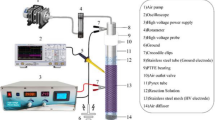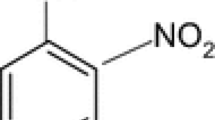Abstract
Clothianidin served as the model pollutant to investigate the performance and mechanism of pollutant removal by dielectric barrier discharge plasma (DBD) combined with the titanium dioxide-reduced graphene oxide (rGO-TiO2) composite catalyst. In this study, different ratios of titanium dioxide-graphene catalysts were loaded onto honeycomb ceramic plates via the sol-gel method, and the modified catalytic ceramic plates were characterized by XRD, SEM, FTIR, DRS, and energy dispersive X-ray. The results suggested that the rGO-TiO2 was well loaded on the surface of the honeycomb ceramic plates. According to the results of the characterization experiments and the degradation of the clothianidin solution with different proportions of the catalyst, 8 wt% rGO-TiO2 was selected as the optimum ratio for degradation. Clothianidin degradation efficiency was significantly influenced by input power, clothianidin concentration, pH value, liquid conductivity, free radical quencher. Finally, six degradation products of clothianidin were identified by HPLC-MS, and the possible transformation pathways of clothianidin degradation were identified.

Graphical abstract







Similar content being viewed by others
References
Anderson C, Bard AJ (1997) Improved photocatalytic activity and characterization of mixed TiO2/SiO2 and TiO2/Al2O3 materials. J Phys Chem B 101:2611–2616. https://doi.org/10.1021/jp9626982
Anh Thu N, Juang R-S (2015) Photocatalytic degradation of p-chlorophenol by hybrid H2O2 and TiO2 in aqueous suspensions under UV irradiation. J Environ Manag 147:271–277. https://doi.org/10.1016/j.jenvman.2014.08.023
Bader H, Hoigné J (1981) Determination of ozone in water by the indigo method. Water Res 15(4):449–456
Baroch P, Saito N, Takai O (2008) Special type of plasma dielectric barrier discharge reactor for direct ozonization of water and degradation of organic pollution. J Phys D Appl Phys 41:085207. https://doi.org/10.1088/0022-3727/41/8/085207
Cao G, Li Y, Zhang Q, Wang H (2010) Synthesis and characterization of La2O3/TiO2-xFx and the visible light photocatalytic oxidation of 4-chlorophenol. J Hazard Mater 178:440–449. https://doi.org/10.1016/j.jhazmat.2010.01.101
Chen Y, Sun L, Yu Z, Wang L, Xiang G, Wan S (2015) Synergistic degradation performance and mechanism of 17 beta-estradiol by dielectric barrier discharge non-thermal plasma combined with Pt-TiO2. Sep Purif Technol 152:46–54. https://doi.org/10.1016/j.seppur.2015.07.061
Chen M, Lo S, Lee Y, Kuo J, Wu C (2016) Decomposition of perfluorooctanoic acid by ultraviolet light irradiation with Pb-modified titanium dioxide. J Hazard Mater 303:111–118. https://doi.org/10.1016/j.jhazmat.2015.10.011
Clochard MC, Melilli G, Rizza G, Madon B, Alves M, Wegrowe JE, Toimil-Molares ME, Christian M, Ortolani L, Rizzoli R, Morandi V, Palermo V, Bianco S, Pirri F, Sangermano M (2016) Large area fabrication of self-standing nanoporous graphene-on-PMMA substrate. Mater Lett 184:47–51. https://doi.org/10.1016/j.matlet.2016.07.133
Eisenberg G (1943) Colorimetric determination of hydrogen peroxide. Ind Eng Chem Anal Ed 15(5):327–328
Elsellami L, Lachheb H, Houas A (2015) Synthesis, characterization and photocatalytic activity of Li-, Cd-, and La-doped TiO2. Mater Sci Semicond Process 36:103–114. https://doi.org/10.1016/j.mssp.2015.03.032
Feng J, Zheng Z, Sun Y, Luan J, Wang Z, Wang L, Feng H (2008) Degradation of diuron in aqueous solution by dielectric barrier discharge. J Hazard Mater 154:1081–1089. https://doi.org/10.1016/j.jhazmat.2007.11.013
Gao X, Peng W, Tang G, Guo Q, Luo Y (2018) Highly efficient and visible-light-driven BiOCl for photocatalytic degradation of carbamazepine. J Alloys Compd 757:455–465. https://doi.org/10.1016/j.jallcom.2018.05.081
Giampiccolo A, Tobaldi DM, Leonardi SG, Murdoch BJ, Seabra MP, Ansell MP, Neri G, Ball RJ (2019) Sol gel graphene/TiO2 nanoparticles for the photocatalytic-assisted sensing and abatement of NO2. Appl Catal B Environ 243:183–194. https://doi.org/10.1016/j.apcatb.2018.10.032
Grymonpre DR, Sharma AK, Finney WC, Locke BR (2001) The role of Fenton’s reaction in aqueous phase pulsed streamer corona reactors. Chem Eng J 82:189–207. https://doi.org/10.1016/s1385-8947(00)00345-4
Hao XL, Zhou MH, Lei LC (2007) Non-thermal plasma-induced photocatalytic degradation of 4-chlorophenol in water. J Hazard Mater 141:475–482. https://doi.org/10.1016/j.jhazmat.2006.07.012
Hoang Hai N, Kim K-S (2015) Combination of plasmas and catalytic reactions for CO2 reforming of CH4 by dielectric barrier discharge process. Catal Today 256:88–95. https://doi.org/10.1016/j.cattod.2015.04.034
Hu Y, Bai Y, Li X, Chen J (2013) Application of dielectric barrier discharge plasma for degradation and pathways of dimethoate in aqueous solution. Sep Purif Technol 120:191–197. https://doi.org/10.1016/j.seppur.2013.10.005
Li S, Ma X, Jiang Y, Cao X (2014) Acetamiprid removal in wastewater by the low-temperature plasma using dielectric barrier discharge. Ecotoxicol Environ Saf 106:146–153. https://doi.org/10.1016/j.ecoenv.2014.04.034
Li S, Ma X, Liu L, Cao X (2015) Degradation of 2,4-dichlorophenol in wastewater by low temperature plasma coupled with TiO2 photocatalysis. RSC Adv 5:1902–1909. https://doi.org/10.1039/c4ra10797g
Li S, Xu Y, Wang X, Guo Y, Mu Q (2016) Catalytic degradation of 4-chlorophenol with La/TiO2 in a dielectric barrier discharge system. RSC Adv 6:28994–29002. https://doi.org/10.1039/c6ra02807a
Li S, Wang X, Liu L, Guo Y, Mu Q, Mellouki A (2017) Enhanced degradation of perfluorooctanoic acid using dielectric barrier discharge with La/Ce-doped TiO2. Environ Sci Pollut Res Int 24:15794–15803. https://doi.org/10.1007/s11356-017-9246-4
Li Y, Li YD, Liu YM, Ward TJ (2018) Photodegradation of clothianidin and thiamethoxam in agricultural soils. Environ Sci Pollut Res 25:31318–31325. https://doi.org/10.1007/s11356-018-3121-9
Liang X, Zhang Y, Li D, Wen B, Jiang D, Chen M (2019) 2D/2D BiOCl/K+Ca2Nb3O10- heterostructure with Z-scheme charge carrier transfer pathways for tetracycline degradation under simulated solar light. Appl Surf Sci 466:863–873. https://doi.org/10.1016/j.apsusc.2018.10.057
Liu W, Cai J, Ding Z, Li Z (2015) TiO2/RGO composite aerogels with controllable and continuously tunable surface wettability for varied aqueous photocatalysis. Appl Catal B Environ 174-175:421–426. https://doi.org/10.1016/j.apcatb.2015.03.041
Liu D, Wu Z, Tian F, Ye B-C, Tong Y (2016) Synthesis of N and La co-doped TiO2/AC photocatalyst by microwave irradiation for the photocatalytic degradation of naphthalene. J Alloys Compd 676:489–498. https://doi.org/10.1016/j.jallcom.2016.03.124
Magureanu M, Piroi D, Mandache NB, David V, Medvedovici A, Parvulescu VI (2010) Degradation of pharmaceutical compound pentoxifylline in water by non-thermal plasma treatment. Water Res 44:3445–3453. https://doi.org/10.1016/j.watres.2010.03.020
Min Y, Zhang K, Zhao W, Zheng F, Chen Y, Zhang Y (2012) Enhanced chemical interaction between TiO2 and graphene oxide for photocatalytic decolorization of methylene blue. Chem Eng J 193:203–210. https://doi.org/10.1016/j.cej.2012.04.047
Mulligan RA, Tomco PL, Howard MW, Schempp TT, Stewart DJ, Stacey PM, Ball DB, Tjeerdema RS (2016) Aerobic versus anaerobic microbial degradation of clothianidin under simulated California rice field conditions. J Agric Food Chem 64:7059–7067. https://doi.org/10.1021/acs.jafc.6b02055
Park M, Kwak BS, Jo SW, Kang M (2015) Effective CH4 production from CO2 photoreduction using TiO2/x mol% Cu-TiO2 double-layered films. Energy Convers Manag 103:431–438. https://doi.org/10.1016/j.enconman.2015.06.029
Pietrzak D, Wator K, Pekala D, Wojcik J, Chochorek A, Kmiecik E, Kania J (2019) LC-MS/MS method validation for determination of selected neonicotinoids in groundwater for the purpose of a column experiment. J Environ Sci Health B 54:424–431. https://doi.org/10.1080/03601234.2019.1574173
Prabhu S, Cindrella L, Kwon OJ, Mohanraju K (2019) Photoelectrochemical, photocatalytic and photochromic performance of rGO-TiO2-WO3 composites. Mater Chem Phys 224:217–228. https://doi.org/10.1016/j.matchemphys.2018.12.030
Radolinski J, Wu JX, Xia K, Hession WC, Stewart RD (2019) Plants mediate precipitation-driven transport of a neonicotinoid pesticide. Chemosphere 222:445–452. https://doi.org/10.1016/j.chemosphere.2019.01.150
Ren JY, Jiang N, Shang KF, Lu N, Li J, Wu Y (2019) Synergistic degradation of trans-ferulic acid by water falling film DBD plasma coupled with cobalt oxyhydroxide: performance and mechanisms. Chem Eng J 372:321–331. https://doi.org/10.1016/j.cej.2019.04.147
Sang W, Cui J, Feng Y, Mei L, Zhang Q, Li D, Zhang W (2019) Degradation of aniline in aqueous solution by dielectric barrier discharge plasma: mechanism and degradation pathways. Chemosphere 223:416–424. https://doi.org/10.1016/j.chemosphere.2019.02.029
Shende TP, Bhanvase BA, Rathod AP, Pinjari DV, Sonawane SH (2018) Sonochemical synthesis of Graphene-Ce-TiO2 and Graphene-Fe-TiO2 ternary hybrid photocatalyst nanocomposite and its application in degradation of crystal violet dye. Ultrason Sonochem 41:582–589. https://doi.org/10.1016/j.ultsonch.2017.10.024
Sun B, Sato M, Clements JS (1997) Optical study of active species produced by a pulsed streamer corona discharge in water. J Electrost 39:189–202. https://doi.org/10.1016/s0304-3886(97)00002-8
Van Dijk TC, Van Staalduinen MA, Van der Sluijs JP (2013) Macro-invertebrate decline in surface water polluted with imidacloprid. PLoS One 8:8. https://doi.org/10.1371/journal.pone.0062374
Vanraes P, Willems G, Nikiforov A, Surmont P, Lynen F, Vandamme J, Van Durme J, Verheust YP, Van Hulle SWH, Dumoulin A, Leys C (2015) Removal of atrazine in water by combination of activated carbon and dielectric barrier discharge. J Hazard Mater 299:647–655. https://doi.org/10.1016/j.jhazmat.2015.07.075
Wang P, Ao Y, Wang C, Hou J, Qian J (2012) Enhanced photoelectrocatalytic activity for dye degradation by graphene–titania composite film electrodes. J Hazard Mater 223-224:79–83. https://doi.org/10.1016/j.jhazmat.2012.04.050
Wang YH, Zhang Y, Zeng T, Li W, Yang L, Guo BY (2019a) Accumulation and toxicity of thiamethoxam and its metabolite clothianidin to the gonads of Eremias argus. Sci Total Environ 667:586–593. https://doi.org/10.1016/j.scitotenv.2019.02.419
Wang Z, Deb A, Srivastava V, Iftekhar S, Arnbat I, Sillanpaa M (2019b) Investigation of textural properties and photocatalytic activity of PbO/TiO2 and Sb2O3/TiO2 towards the photocatalytic degradation Benzophenone-3 UV filter. Sep Purif Technol 228:115763. https://doi.org/10.1016/j.seppur.2019.115763
Yu Z, Sun Y, Zhang G, Zhang C (2017) Degradation of DEET in aqueous solution by water falling film dielectric barrier discharge : effect of three operating modes and analysis of the mechanism and degradation pathway. Chem Eng J 317:90–102. https://doi.org/10.1016/j.cej.2017.02.068
Zabar R, Komel T, Fabjan J, Kralj MB, Trebse P (2012) Photocatalytic degradation with immobilised TiO2 of three selected neonicotinoid insecticides: imidacloprid, thiamethoxam and clothianidin. Chemosphere 89:293–301. https://doi.org/10.1016/j.chemosphere.2012.04.039
Zhang J, Zheng Z, Zhang Y, Feng J, Li J (2008) Low-temperature plasma-induced degradation of aqueous 2,4-dinitrophenol. J Hazard Mater 154:506–512. https://doi.org/10.1016/j.jhazmat.2007.10.053
Zhang K, Kemp KC, Chandra V (2012) Homogeneous anchoring of TiO2 nanoparticles on graphene sheets for waste water treatment. Mater Lett 81:127–130. https://doi.org/10.1016/j.matlet.2012.05.002
Zhang P, Sun H, Ren C, Min L, Zhang H (2018a) Sorption mechanisms of neonicotinoids on biochars and the impact of deashing treatments on biochar structure and neonicotinoids sorption. Environ Pollut 234:812–820. https://doi.org/10.1016/j.envpol.2017.12.013
Zhang Q, Zhang H, Zhang Q, Huang Q (2018b) Degradation of norfloxacin in aqueous solution by atmospheric-pressure non-thermal plasma: mechanism and degradation pathways. Chemosphere 210:433–439. https://doi.org/10.1016/j.chemosphere.2018.07.035
Zheng K, Sun Y, Gong S, Jiang G, Zheng X, Yu Z (2019) Degradation of sulfamethoxazole in aqueous solution by dielectric barrier discharge plasma combined with Bi2WO6-rMoS(2) nanocomposite: mechanism and degradation pathway. Chemosphere 222:872–883. https://doi.org/10.1016/j.chemosphere.2019.02.004
Zhu D, Jiang L, Liu R, Chen P, Lang L, Feng J, Yuan S, Zhao D (2014) Wire-cylinder dielectric barrier discharge induced degradation of aqueous atrazine. Chemosphere 117:506–514. https://doi.org/10.1016/j.chemosphere.2014.09.031
Funding
This work was supported by the National Key Research and Development Plan of China (no. 2018YFC0408006), the Natural Science Foundation of China (no. 51978386), and the National Natural Science Foundation of China Joint Fund Project (no. U1906224).
Author information
Authors and Affiliations
Corresponding author
Additional information
Responsible Editor: Suresh Pillai
Publisher’s note
Springer Nature remains neutral with regard to jurisdictional claims in published maps and institutional affiliations.
Electronic supplementary material
ESM 1
(DOCX 1313 kb).
Rights and permissions
About this article
Cite this article
Li, S., Chen, H., Wang, X. et al. Catalytic degradation of clothianidin with graphene/TiO2 using a dielectric barrier discharge (DBD) plasma system. Environ Sci Pollut Res 27, 29599–29611 (2020). https://doi.org/10.1007/s11356-020-09303-0
Received:
Accepted:
Published:
Issue Date:
DOI: https://doi.org/10.1007/s11356-020-09303-0




